You may recall in May I set out “jug traps” at several sites in northwestern Oklahoma stretching from Gloss Mountain State Park (just east of the panhandle) to near Kenton (extreme northwestern corner of the panhandle). I call them “jug traps” because they are made out of 1-G milk jugs. “Windows” cut into the upper part of the jug allow entry of beetles attracted to volatiles emanating from a wicked bait bottle suspended inside the upper part of the trap, and propylene glycol in the bottom part of the jug acts as a killing agent and preservative. (See this post for details about the traps and photos.) Six sets of traps were set out at five locations (two sets at Gloss Mountain, one at other locations)—each set consisting of three traps baited with sweet red wine, pure ethanol, or a 50:50 mixture of both. This is the second season of the study (the first was conducted last year at locations across southern Missouri) with the objective of evaluating the efficacy of the trap and baits for capturing various beetles. Longhorned beetles (family Cerambycidae) are the primary objective, but certain cetoniine scarabs (flower chafers in the genera Euphoria and Cotinus) and click beeltes (family Elateridae) are also highly attracted to the traps. I’m collecting data on all of these groups for analysis of relative bait efficacy and eventual publication of the results.
In addition to the jug traps, I also placed white “bottle traps” at each location with the objective of collecting beetles in the genus Acmaeodera (family Buprestidae). Finally, to round out the trapping effort I hung a Lindgren funnel trap (baited with a 50:50 mixture of ethanol and sweet red wine) at two of the locations (just for the heck of it!). All of the traps are being serviced and re-baited at ~5-week intervals—the first of these servicing runs done at the beginning of a 3-week collecting trip across the southwestern U.S. Additional collecting is done at each location as time permits. This post presents notes and photos from the second trap servicing run, which took place from 25–29 July 2023.
Day 1 — 25 July 2023
Alabaster Caverns State Park
Woodward County, Oklahoma
It’s been five weeks since I last checked the jug traps I placed in northwestern Oklahoma, so today begins a four-day run to take care of them. I’m alone this time (for the first time this year 😢), so instead of conversation I had to rely on a backlog of podcasts to keep me engaged during the 8-hour drive to this, the first of four stops. I got to here about the same time as last time—6 p.m., and it was just as hot (if not hotter—103°F) as last time; however, the heat did not seem to bother me this time. Perhaps all the collecting I’ve done over the past month has me now nicely acclimated. I set about to check the traps and was pleased to find all three hanging intact and apparently undisturbed (always a concern when I check traps). Similarly to last time, Euphoria fulgida was a dominant capture in all three traps, but a nice variety of Cerambycidae were captured as well (nine species total), including the very uncommon Trigonarthris atrata and the first capture of Clytoleptus albofasciatus. There wasn’t much going on in the shortgrass prairie above the canyon, so I headed down to the campground inside the canyon with hopes of a productive evening of blacklighting.
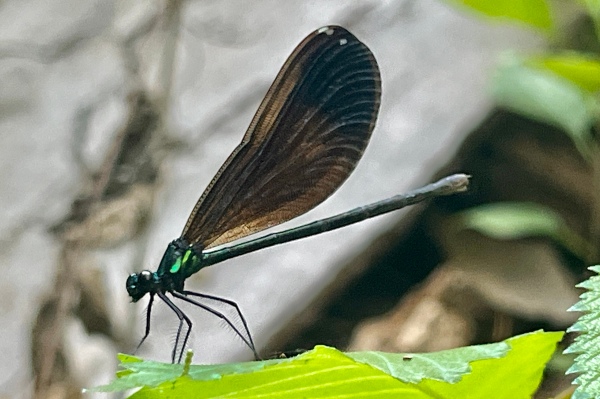
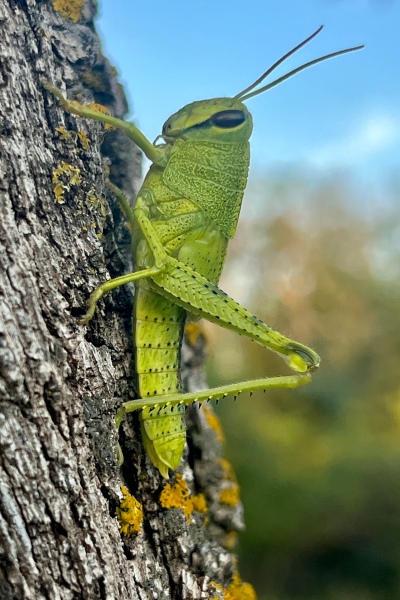
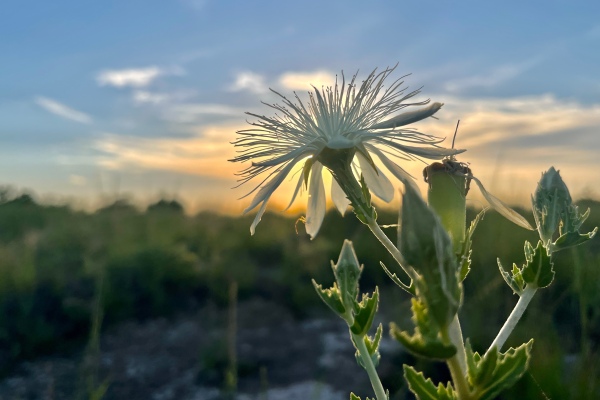
I still had about an hour of daylight left when I arrived at the campground, which gave me plenty of time to get coals going for dinner, set up camp, and set out the lights (both ultraviolet [UV] and mercury-vapor [MV]). For a while it was mostly hemipterans (leafhoppers, leaf-footed bugs, stink bugs, and Neotibicen superbus) coming to the lights (I collected a handful of the latter along with a single N. lyricens that also came), but later I started picking up a few interesting things including Eburia quadrigeminata (that answers my question as to whether E. haldemani might occur this far north to replace E. quadrigeminata from the east), a couple of Smodicum cucujiforme, a Telamona sp., and a handful of small Cleridae and Bostrichidae.

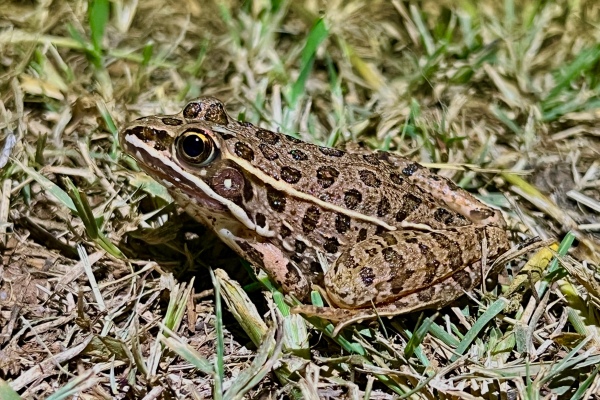
Day 2—26 July 2023
It was rather warm sleeping, but by the morning temperatures had cooled off nicely and a thin cloud layer promised to keep them from rising too rapidly. After breaking down camp (and coffee!), I checked the Lindgren funnel trap: it had a smattering of Cerambycidae and other insects, but nothing rare or in large numbers. I also noticed a rather large dead branch in the Salix nigra (black willow) tree overhanging the tent—recalling my capture last time of Poecilonota thureura on the tent, I thought perhaps this could have been the source of it and collected the branch for rearing. On the way out to my next locality, I checked the bottle trap that I placed last time and found only a single Acmaeodera sp. along with a Trichiotinus texanus and a few Meloidae (also 10 bees for Mike).

Gloss Mountain State Park
Major County, Oklahoma
I wasn’t quite prepared for what I found in the traps this time, although I should have had a clue considering how many Euphoria beetles that were in them last time. The Euphoria-overload has not subsided since then, and as well other insects—namely Plinthocoelium suaveolens and Elateridae—were trapped in overwhelming numbers. I didn’t think to bag the catch and wait for a more comfortable situation to count the specimens until I was already on top of the mesa and committed to filed-counts, and as a result it took me almost three hours to count just the first two traps (one of them had 750 Elateridae!). I finally got smart with the third trap and brought its contents down to the parking area to count at the table and shelter. The traps down below were not as overwhelmed by Elateridae as the traps above, but P. suaveolens were still quite abundant. I did get two new bait trap captures—Knulliana cincta and Plionoma suturalis. I also got a few Eburia that look like the eastern E. quadrigeminata rather than E. haldemani. The last trap (EtOH-only down below) was compromised—broken and with the contents dried to a crisp and unsalvageable. Since the lower set of traps was compromised last time (by wind), I decided not to replace the trap and will exclude the lower set of traps from the data analysis (a shame since there were two species in the traps this time that I have not gotten in any other trap—oh well, in science you live by the rules and you die by them!). In total, at least 14 species of Cerambycidae were present in the traps (including another Aethecerinus wilsonii, which I collected for the first time ever last month near Black Mesa). There were only a few Acmaeodera mixta/immaculata in the bottle traps, but since I have not collected this complex commonly here before and it seems to be a transition zone from one to the other any additional specimens are welcome. By the time I finished counting the last trap, it was almost 6 pm and temps had risen from 95°F at the start to 106°F! I knew it was hot and that I was getting quite dehydrated (despite a food/water break between the two sets of traps), but I didn’t realize just how badly until I started guzzling liquids non-stop after I got back to the vehicle and made a beeline for the nearest town to get even more cold liquids before heading off to the next location.

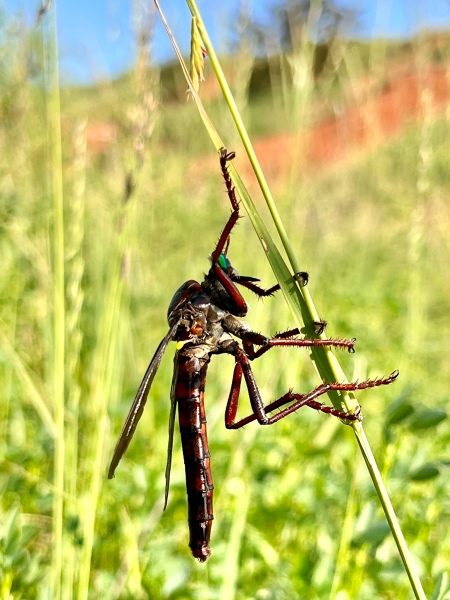
Beaver Dunes Park
Beaver County, Oklahoma
As with Alabaster Caverns the night before, I reached the campground with about an hour of daylight and set up camp, cooked dinner, and set up the lights (both ultraviolet and mercury-vapor). It was a good night for lighting, with still warm though not uncomfortable temps, although the now 1st-quarter moon was noticeably brighter than the night before. Right off the bat I got a Megatibicen dealbatus (plains cicada) and a couple of Polyphylla sp., and over the course of the evening I would get one more of the former and plenty of the latter. Cerambycid-wise, however, I got a single Eburia sp. and one elaphidiine, so not overwhelming. The Eburia looks like it could be E. haldemani, which would be interesting since at the two spots further east the Eburia I collected there look like E. quadrigeminata. The lights shut down a bit early, as the generator ran out of gas and I decided not to hook up the ultraviolet-only lights to the car. With the clatter of the generator suddenly gone, I was able to enjoy the nights sounds that I’d been missing to that point. The unusually wet year the area has been having meant not only that the landscape is unusually green, but the normally dry marsh behind the tent area is full of water—and bull frogs bleating their monotonous calls. Megatibicen dealbatus continued to sing in the taller cottonwoods around the campground—I wasn’t aware the song of this species was so similar to that of the more eastern M. pronotalis (Walker’s cicada), nor that they called as late into the night as this. In fact, few cicadas in my area call deep into the night, a notable exception being M. auletes. I guess it’s not surprising to learn that M. dealbatus does as well, as they are both in the same genus.

Day 3 — 27 July 2023
Lower temps and cloud cover were welcome developments this morning, and since I was already at the site where I would be checking traps I was able to get started earlier and be done before temps got too high. The area has evidently gotten a lot of rain recently, so much so that the 2-track shortcut to my traps was washed out and impassable (had to back up a long way… uphill!). I was glad to see the Euphoria extravaganza had ended with no consequent Eburia explosion like there would be in Missouri right now (although here I WANT to see Eburia as they are likely E. haldemani). Elaphidiines seem to rule the cerambycid diversity at this spot—I suppose most/all are associated with the Celtis reticulata that dominates the woodlands around the sand dune margins. Only a smattering of other Cerambycidae were present, none of which were especially unusual. There were about a dozen Acmaeodera in the bottle trap—they look mostly like A. immaculata in this area (along with a variety of bees for Mike).

Near Lake Etling
Cimmaron County, Oklahoma
After finishing at Beaver Dunes, I made the 3-hour drive to Black Mesa State Park (despite the worrying clouds in the direction I’m going!). Just before getting there, I stopped at this spot—given to me by fellow cicindeliphile Dan Duran, who a few days ago saw Cicindela nigrocoerulea, a species I have not yet collected. There was an abundance of grasshoppers and several different types of robber flies, but tiger beetle-wise the only species I saw/collected was the über-widespread Cicindelidia punctulata along with a ground nesting bee (for MIke).


1.6 mi E Kenton
Cimmaron County, Oklahoma
The worrying clouds worsened, and by the time I arrived at this spot a few miles northwest of Black Mesa State Park (my ultimate destination) a steady roll of thunder could be heard in the near distance. I decided to bag it—not as in ‘give up,’ but to literally place the trap catch in bags for later counting. The dreaded Euphoria overrun did not materialize, but not did I see anything that looked beyond the usual (I’ll have to wait for the counts to know if I should be pleased or not). I worked with some urgency as the thunder grew nearer and light rain began to fall on me. The catch in the third trap was not overwhelming, so rather than bagging it I brought it back to the car and sorted it there as long as I could manage before the rain became too heavy. Only a handful of Cerambycidae were trapped, none uncommon or in large numbers, but the bottle trap contained more than a hundred Acmaeodera sp. (A. immaculata I suspect) and lots of bees (for Mike). The most exciting capture was not in the traps, but a male Prionus heroicus that I captured in flight (I saw two others, but they never approached closely enough).

Black Mesa State Park
Cimmaron County, Oklahoma
Before the rain hit too hard to continue, I managed to service the bottle and Lindgren funnel traps. The former was swamped by perhaps a couple hundred or more of a largish bee species (but curiously not a single Acmaeodera!), while the catch of the latter was in the early stages of decay and could not be salvaged (not sure why, the reservoir should have contained 50% propylene glycol just like all other traps set out this season). Once the rain really started falling, it did not stop. I took advantage of the opportunity to go into town and pick up supplies—perhaps hoping by the time I returned the rain would have stopped and I could proceed with checking the remaining traps or at least set up camp. Such was not the case, and eventually with impending darkness I went ahead and set up while it was still lightly raining. The tent suffered a bit of moisture inside but not too bad, and with the rain fly in place and room to spare inside it was a comfortable place to catch up on my notes. Briquettes were also started in the rain but, thankfully, proceeded to embers, helped along by the eventual end of rain. I would have preferred to have been setting up lights for night collecting—or at least sitting at the table outside so I could process the trap contents that I bagged, but I did enjoy spectacular views as the rain ended amidst dwindling daylight (the rainbow view from my tent was unsurpassed!). After dark, I took a short walk to the park showers to see if any nocturnal insects were walking the roads or had been attracted to the bathroom building lights. Sadly, the park utilizes “low bug” yellow bulbs, so it was a fruitless excursion other than fulfilling the need to move the legs once more before settling down for the evening.



Day 4 — 28 July 2023
I came back in the morning to finish the job with the three jug traps placed in the hackberry/soapberry woodland canyon below the overlook. Again, I bagged the catches from the three traps, not because they were overrun by the beetles that I’m counting, but because they were overwhelmed by hackberry butterflies and millions of tiny sap beetles that would have extended the counting time into the afternoon. Given the 11-hour drive I had to get back to St. Louis, I decided it was best to bag them and count them later so I could arrive home in the evening at a reasonable hour. Also, I ran out of propylene glycol after servicing the bottle and Lindgren funnel traps, so I used straight antifreeze (diluted ethylene glycol) purchased in town to refill the reservoirs of the three jug traps. Functionally it performs the same as diluted propylene glycol, but I prefer to avoid using it when possible since it could be toxic if ingested by wildlife.

Elaphidiines were super abundant in all three traps—at least three species could be discerned, and Neoclytus mucronatus (apparently the “vogti” form) were also abundant. The most exciting find, however, was a Megacyllene sp. that looks distinctly like M. antennata—if this is the case, it would represent a significant northward extension to the known range!
©️ Ted C. MacRae 2023